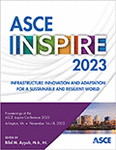Indirect Economic Impacts due to Transportation Disruptions: A Modified CGE Model for Passenger Flow Disturbance
Publication: ASCE Inspire 2023
ABSTRACT
Transportation systems are vital for cities’ emergency response activities and for long-term recovery during and after natural or man-made hazards. While their networked nature enables the mobility of humans, goods, and services, the same characteristic exposes transportation systems to complex failures, which can impact the economic system at multiple scales beyond the immediate location of the hazard. A series of economic methods have been used for the assessment of the economic impacts of transportation disruptions. However, previous studies have not adequately investigated the indirect economic impacts of transportation disruptions in terms of passenger flow disturbances. Especially, the indirect economic impacts of changes in households’ available time (such as work and leisure) due to transportation disruptions were overlooked. This paper introduces an explicit estimation model that was constructed based on the computable general equilibrium model with consideration of the time constraint. The relationships between the households’ time spent on a series of activities and household utility are illustrated. This model can be integrated into the interdisciplinary framework proposed in the authors’ previous research based on hazard characterization and damage assessment, analyses of transportation systems, and economic models, that achieved a more comprehensive understanding of the economic impacts of transportation disruptions.
Get full access to this article
View all available purchase options and get full access to this chapter.
REFERENCES
Chen, Z., A. Z. Rose, F. Prager, and S. Chatterjee. (2017). “Economic consequences of aviation system disruptions: A reduced-form computable general equilibrium analysis.” Transp. Res. Part A Policy Pract., 95: 207–226.
Ding, W., and J. Wu. (2023). “Interregional economic impacts of an extreme storm flood scenario considering transportation interruption: A case study of Shanghai, China.” Sustainable Cities Soc., 88: 104296.
Enke, D. L., C. Tirasirichai, and R. Luna. (2008). “Estimation of Earthquake Loss due to Bridge Damage in the St. Louis Metropolitan Area. II: Indirect Losses.” Nat. Hazard. Rev., 9 (1): 12–19.
Gajanayake, A., G. Zhang, T. Khan, and H. Mohseni. (2020). “Postdisaster Impact Assessment of Road Infrastructure: State-of-the-Art Review.” Nat. Hazard. Rev. 21 (1): 03119002.
Gilchrist, A., and E. N. Allouche. (2005). “Quantification of social costs associated with construction projects: State-of-the-art review.” Tunnelling Underground Space Technol., 20 (1): 89–104.
Gordon, P., H. W. Richardson, and B. Davis. (1998). “Transport-Related Impacts of the Northridge Earthquake.” Journal of Transportation and Statistics, 1 (2): 21–36.
Horridge, M. (2012). “The TERM Model and Its Database.” Economic Modeling of Water, 13–35. Springer.
Koc, E., B. Cetiner, A. Rose, L. Soibelman, E. Taciroglu, and D. Wei. (2020). “CRAFT: Comprehensive Resilience Assessment Framework for Transportation Systems in Urban Areas.” Adv. Eng. Inf., 46.
Postance, B., J. Hillier, T. Dijkstra, and N. Dixon. (2017). “Extending natural hazard impacts: an assessment of landslide disruptions on a national road transportation network.” Environ. Res. Lett., 12 (1).
Shi, Y., and S. Wang. (2013). “Indirect economic loss estimation due to seismic highway transportation system disruption in ‘5.12’ wenchuan earthquake.” Journal of Disaster Research, 8 (5): 1018–1024.
Wei, D., Z. Chen, A. Rose, J. Banks, and N. Miller. (2016). Development and Application of an Economic Framework to Evaluate Resilience in Recovering from Major Port Disruptions.
Wei, D., A. Rose, E. Koc, Z. Chen, and L. Soibelman. (2022a). “Socioeconomic impacts of resilience to seaport and highway transportation network disruption.” Transp. Res. Part D Transp. Environ., 106 (April): 103236.
Wei, F., E. Koc, N. Li, L. Soibelman, and D. Wei. (2022b). “A data-driven framework to evaluate the indirect economic impacts of transportation infrastructure disruptions.” Int. J. Disaster Risk Reduct., 75 (December 2021): 102946.
Wei, F., E. Koc, L. Soibelman, and N. Li. (2018a). “Disaster Economics and Networked Transportation Infrastructures: Status Quo and a Multi-disciplinary Framework to Estimate Economic Losses.” Advanced Computing Strategies for Engineering, I. F. C. Smith and B. Domer, eds., 3–22. Springer International Publishing.
Wei, F., E. Koc, L. Soibelman, and N. Li. (2018b). “Disturbances to Urban Mobility and Comprehensive Estimation of Economic Losses.” Polytechnica, 1 (1–2): 48–60.
Xie, W., N. Li, C. Li, J. D. Wu, A. Hu, and X. Hao. (2014). “Quantifying cascading effects triggered by disrupted transportation due to the Great 2008 Chinese Ice Storm: Implications for disaster risk management.” Nat. Hazard., 70 (1): 337–352.
Zhang, X., and N. Li. (2022). “Characterizing individual mobility perturbations in cities during extreme weather events.” Int. J. Disaster Risk Reduct., 72 (February): 102849.
Information & Authors
Information
Published In
History
Published online: Nov 14, 2023
ASCE Technical Topics:
- Analysis (by type)
- Business management
- Computer models
- Disaster preparedness
- Disaster risk management
- Disasters and hazards
- Economic factors
- Emergency management
- Engineering fundamentals
- Infrastructure
- Man-made disasters
- Models (by type)
- Passengers
- Practice and Profession
- Public transportation
- System analysis
- Transportation engineering
- Transportation management
- Transportation studies
Authors
Metrics & Citations
Metrics
Citations
Download citation
If you have the appropriate software installed, you can download article citation data to the citation manager of your choice. Simply select your manager software from the list below and click Download.
